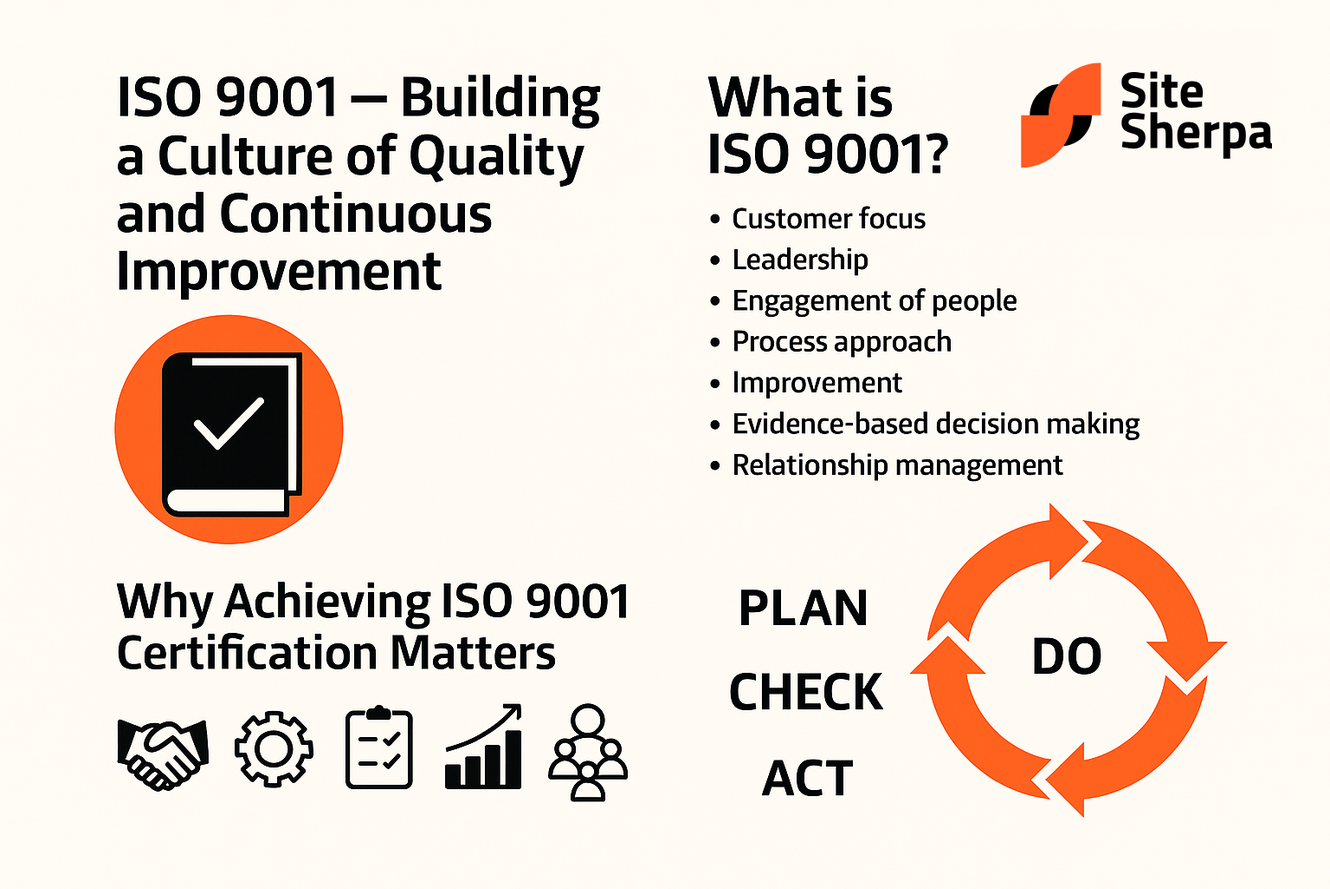ISO 9001 – Building a Culture of Quality and Continuous Improvement
Discover how ISO 9001 can transform your organisation into a quality-driven, efficient, and customer-focused powerhouse
In an increasingly competitive business environment, organisations need more than just a great product or service to stand out. Customers expect consistent quality, transparent processes, and ongoing improvement. One of the most recognised ways to demonstrate this commitment is through ISO 9001, the internationally accepted standard for quality management systems (QMS).
Whether you operate in construction, manufacturing, healthcare, technology, or services, implementing ISO 9001 can help you streamline operations, enhance customer satisfaction, and maintain compliance with regulatory requirements.
What is ISO 9001?
ISO 9001 is part of the ISO 9000 family of quality management standards developed by the International Organization for Standardization. It sets out the criteria for a QMS, focusing on principles such as:
- Customer focus – Understanding and meeting customer needs consistently.
- Leadership – Creating a vision for quality and setting the tone from the top.
- Engagement of people – Ensuring all staff are empowered and involved in delivering quality outcomes.
- Process approach – Managing activities and resources as interconnected processes.
- Improvement – Encouraging a culture of ongoing enhancement.
- Evidence-based decision making – Using data to guide strategic and operational choices.
- Relationship management – Building strong partnerships with suppliers and stakeholders.
These principles ensure that quality isn’t just a department’s responsibility, it’s embedded into the entire organisation.
Why Achieving ISO 9001 Certification Matters
For many organisations, ISO 9001 certification is more than just a “badge of honour.” It delivers tangible benefits:
1. Increased Customer Confidence
Certification demonstrates that your organisation meets internationally recognised quality standards, giving customers assurance in your processes and outcomes.
2. Operational Efficiency
The structured framework encourages you to map, measure, and optimise workflows, reducing waste, errors, and inefficiencies.
3. Compliance and Risk Management
ISO 9001 aligns with many industry regulations, helping organisations stay compliant and manage risks more effectively.
4. Competitive Advantage
In many tenders, contracts, and procurement processes, ISO 9001 certification is a pre-requisite. Holding it can open doors to new business opportunities.
5. Employee Engagement
A clear quality policy and defined procedures give staff a better understanding of their roles and how they contribute to organisational success.
Key Steps in Implementing ISO 9001
Implementing a quality management system that aligns with ISO 9001 involves a structured approach:
- Gap Analysis
- Evaluate your current processes against the requirements of the standard. Identify where changes are needed.
- Leadership Commitment
- Senior management must champion the implementation, set objectives, and ensure resources are allocated.
- Process Documentation
- Document your quality policy, procedures, work instructions, and records to provide a clear framework for operations.
- Training and Awareness
- Ensure employees understand the standard’s requirements and how they apply to their daily work.
- Internal Audits
- Conduct regular internal audits to check compliance and identify areas for improvement.
- Management Review
- Hold periodic reviews to evaluate performance against quality objectives and make strategic adjustments.
- Certification Audit
- Engage an accredited certification body to conduct the external audit and verify compliance.
Common Challenges and How to Overcome Them
Implementing ISO 9001 can be straightforward with the right approach, but common challenges include:
- Resistance to change – Overcome this by involving employees early in the process and showing the benefits.
- Documentation overload – Keep documents practical, concise, and relevant to daily operations.
- Maintaining momentum – Build continuous improvement into your business culture so the system evolves over time.
ISO 9001 and Continuous Improvement
One of the most powerful aspects of ISO 9001 is its emphasis on continuous improvement. The Plan-Do-Check-Act (PDCA) cycle underpins the standard, guiding organisations to:
- Plan – Establish objectives and processes.
- Do – Implement the processes.
- Check – Monitor and measure against objectives.
- Act – Take action to improve performance.
This ongoing loop ensures your organisation is always looking for ways to improve efficiency, quality, and customer satisfaction.
Integrating ISO 9001 with Other Management Systems
Many organisations integrate ISO 9001 with other standards such as ISO 45001 (Occupational Health and Safety) or ISO 14001 (Environmental Management). This integrated management system (IMS) approach reduces duplication, streamlines audits, and aligns quality, safety, and environmental objectives into a single, cohesive framework.
For example, safety-critical industries often combine quality management principles with health and safety processes, ensuring that operational excellence and worker protection go hand in hand.
Is ISO 9001 Right for Your Organisation?
If your organisation values customer satisfaction, operational efficiency, and compliance, ISO 9001 is worth considering. While certification requires effort and resources, the benefits from improved market reputation to reduced operational waste make it a sound investment.
Even if you’re not seeking certification immediately, adopting the principles of ISO 9001 can still transform your processes and culture for the better.
Final Word
In a marketplace where quality and reliability are key differentiators, ISO 9001 offers a proven pathway to operational excellence. By embedding its principles into your organisation, you not only meet customer expectations but consistently exceed them. Whether you are a small business or a multinational, the framework helps you work smarter, respond faster, and stay competitive in an ever-changing world.
Related Content
Join Our Newsletter
Receive expert insights, safety updates, and the latest updates in our services and apps. Stay ahead of workplace safety, compliance, and operational efficiency delivered straight to your inbox.


.png)
.png)
.png)
.png)
.png)
.png)
.png)
.png)
.png)